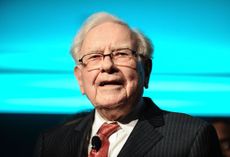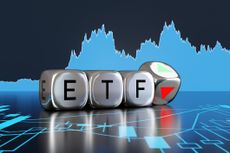Two investment trusts riding the AI boom
AI breakthroughs are likely to change the world, so remain invested despite high valuations. Max King highlights two investment trusts worth holding

At the £3.6 billion Polar Capital Technology Trust’s (LSE: PCT) annual general meeting in September, manager Ben Rogoff said, “It doesn’t feel like AI is in a bubble to us – AI is a theme that should dominate every portfolio”.
Many historic innovations greatly increased productivity, says Rogoff: horsepower by 50 times, the tractor by four times and the sewing machine by 22 times. AI has the potential to do the same: already, companies are reporting significant efficiency gains. Some 60% of workers today are employed in occupations that did not exist in 1940, he notes. “We cannot know what new opportunities are enabled by AI.”
Industry sources predict that the current $45 billion market for AI chips will grow to $400 billion by 2027, says his colleague Alastair Unwin. Yet a capital expenditure (capex) bubble is unlikely: technology capex is still modest relative to the 2.5% of US GDP that was invested in railways in the mid-1800s.
Subscribe to MoneyWeek
Subscribe to MoneyWeek today and get your first six magazine issues absolutely FREE

Sign up to Money Morning
Don't miss the latest investment and personal finances news, market analysis, plus money-saving tips with our free twice-daily newsletter
Don't miss the latest investment and personal finances news, market analysis, plus money-saving tips with our free twice-daily newsletter
Is AI consuming too much energy?
Sceptics argue that AI will put an intolerable burden on the electricity supply. Such warnings do not take account of increasing energy efficiency, say the Polar team. While the computing power required for AI is growing exponentially – perhaps by as much as 50% per quarter – this should slow to 25% later in the decade.
Google estimates that it could deliver seven times as much computing power with the same amount of electrical power at data centres as five years ago, says Rogoff. Academic research supports this, finding that server power intensity has improved by 16% annually since 2018, while storage power intensity has improved by 24% per year.
Nvidia claims its new range of chips is over 75% more efficient than the previous standard, and over 90% more efficient than chips in use five years ago. Similarly, Dell, which accounts for around 30% of the data-centre storage market, suggests its new suite of storage products is 82% more energy efficient than legacy solutions.
The combination of growth in computing power offset by efficiency gains leads to an estimate that from 2024-2030, demand for power from data centres could grow by 15%- 20% per year, accounting for 4%-5% of global demand for electricity by the end of the period. The investment required of electricity generators and networks is not unduly onerous.
Should you invest?
The focus on AI was a significant driver of PCT’s investment return of 41% in the year to 30 April. In the five subsequent months, progress has slowed but the net asset value was still up 7%.
Unsurprisingly, Nvidia is its largest holding at 11% of the portfolio, but AI “enablers” and “beneficiaries” also feature prominently. The top-10 holdings, which account for 53% of the portfolio, include Microsoft, Apple, Meta, Alphabet and TSMC. Inevitably, North American exposure is high at 71%.
At PCT’s main competitor, the £1.4 billion Allianz Technology Trust (LSE: ATT), the portfolio is similar, although it is more concentrated (45 holdings versus 95) and North American exposure is still higher at 91%. ATT’s performance is better over five years (152% versus 126%), but worse over three years (23% versus 28%).
Both trusts trade at an 11% discount to net asset value (NAV) and both will do well if the technology sector continues to perform. While the S&P IT sector is trading at a 12-year high in terms of absolute valuation and a 10-year high relative to the S&P 500, earnings growth should remain strong. Worldwide IT spending growth has doubled to 7.5% in 2024 and is likely to stay high.
Comparisons to the dotcom bubble are misleading: profits, cash flow and balance sheets have improved greatly and the top firms are far more entrenched. Even if the sector does no worse than mark time, it won’t take long for valuations to fall to more attractive levels.
This article was first published in MoneyWeek's magazine. Enjoy exclusive early access to news, opinion and analysis from our team of financial experts with a MoneyWeek subscription.
Sign up to Money Morning
Our team, led by award winning editors, is dedicated to delivering you the top news, analysis, and guides to help you manage your money, grow your investments and build wealth.

Max has an Economics degree from the University of Cambridge and is a chartered accountant. He worked at Investec Asset Management for 12 years, managing multi-asset funds investing in internally and externally managed funds, including investment trusts. This included a fund of investment trusts which grew to £120m+. Max has managed ten investment trusts (winning many awards) and sat on the boards of three trusts – two directorships are still active.
After 39 years in financial services, including 30 as a professional fund manager, Max took semi-retirement in 2017. Max has been a MoneyWeek columnist since 2016 writing about investment funds and more generally on markets online, plus occasional opinion pieces. He also writes for the Investment Trust Handbook each year and has contributed to The Daily Telegraph and other publications. See here for details of current investments held by Max.
-
 Energy bills to rise by 1.2% in January 2025
Energy bills to rise by 1.2% in January 2025Energy bills are set to rise 1.2% in the New Year when the latest energy price cap comes into play, Ofgem has confirmed
By Dan McEvoy Published
-
 Should you invest in Trainline?
Should you invest in Trainline?Ticket seller Trainline offers a useful service – and good prospects for investors
By Dr Matthew Partridge Published
-
 Should you invest in Trainline?
Should you invest in Trainline?Ticket seller Trainline offers a useful service – and good prospects for investors
By Dr Matthew Partridge Published
-
 BT cuts annual revenue forecast – what's next for the telecoms giant?
BT cuts annual revenue forecast – what's next for the telecoms giant?BT has trimmed its sales forecast, but the overall outlook remains positive and big investors have bought in. Should you invest?
By Dr Matthew Partridge Published
-
 Investment trusts could benefit from more optimism
Investment trusts could benefit from more optimismGive yourself an edge with investment trusts. Finding winning stocks is no mean feat.
By Max King Published
-
 Why the MoneyWeek ETF portfolio won't need to change
Why the MoneyWeek ETF portfolio won't need to changeOur long-running ETF strategy won’t be placing any bets yet about what Donald Trump will do in his new term
By Cris Sholto Heaton Published
-
 Oil sector off the boil: what happens now?
Oil sector off the boil: what happens now?Oil giants BP and Shell are starting to struggle amid a glut of black gold. And growth in demand looks likely to slow
By Dr Matthew Partridge Published
-
 What does the future hold for investment trusts?
What does the future hold for investment trusts?The investment trust sector is consolidating; for the small, illiquid players the future looks bleak
By Rupert Hargreaves Published
-
 Improved prospects for income investors
Improved prospects for income investorsIncome investors are raking in dividends, but it's not from the FTSE 100
By Alex Rankine Published
-
 An overlooked Japanese investment trust to invest in
An overlooked Japanese investment trust to invest inThis Japanese investment trust focuses on family-controlled firms, cheap investment trusts and Japan
By Max King Published